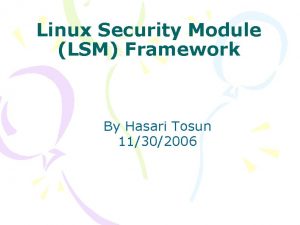Logistics Management LSM 730 Lecture 24 Dr Khurrum










- Slides: 10

Logistics Management LSM 730 Lecture 24 Dr. Khurrum S. Mughal 1 -1

Actions When Forecasting is Not Appropriate · Seek information directly from customers ·Collaborate with other channel members · Apply forecasting methods with caution (may work where forecast accuracy is not critical) · Delay supply response until demand becomes clear · Shift demand to other periods for better supply response · Develop quick response and flexible supply systems CR (2004) Prentice Hall, Inc. 8 -2

Collaborative Forecasting • Demand is lumpy or highly uncertain • Involves multiple participants each with • • a unique perspective—“two heads are better than one” Goal is to reduce forecast error The forecasting process is inherently unstable CR (2004) Prentice Hall, Inc. 8 -3

Collaborative Forecasting: Key Steps • Establish a process champion • Identify the needed Information and collection processes • Establish methods for processing information from multiple sources and the weights assigned to multiple forecasts • Create methods for translating forecast into form needed by each party • Establish process for revising and updating forecast in real time • Create methods for appraising the forecast • Show that the benefits of collaborative forecasting are obvious and real CR (2004) Prentice Hall, Inc. 8 -4

Managing Highly Uncertain Demand ·Delay forecasting as long as possible ·Prioritize supply by product’s degree of uncertainty (supply to the more certain products first) ·Apply the principle of postponement to the most uncertain products (delay committing to a final product form until an order is received) ·Create flexible supply to changing demand (alter capacity and output rates through subcontracting, computer technology, multi-purpose processes, etc. ) ·Be able to respond quickly to uncertain demand levels CR (2004) Prentice Hall, Inc. 8 -5

Inventory Policy Decisions “Every management mistake ends up in inventory. ” Michael C. Bergerac Former Chief Executive Revlon, Inc. CR (2004) Prentice Hall, Inc. 9 -6

CONTROLLING Customer service goals • The product • Logistics service • Ord. proc. & info. sys. Transport Strategy • Transport fundamentals • Transport decisions PLANNING Inventory Strategy • Forecasting • Inventory decisions • Purchasing and supply scheduling decisions • Storage fundamentals • Storage decisions ORGANIZING Inventory Decisions in Strategy Location Strategy • Location decisions • The network planning process CR (2004) Prentice Hall, Inc. 9 -7

What are Inventories? • Finished product held for sale • Goods in warehouses • Work in process • Goods in transit • Staff hired to meet service needs • Any owned or financially controlled raw material, work in process, and/or finished good or service held in anticipation of a sale but not yet sold CR (2004) Prentice Hall, Inc. 9 -8

Where are Inventories? Inbound transportation Production Outbound transportation Finished goods warehousing Customers Receiving Material sources Production materials Finished goods Shipping Inventories in-process Inventory locations CR (2004) Prentice Hall, Inc. 9 -4

Reasons for Inventories • Improve customer service -Provides immediacy in product availability • Encourage production, purchase, and transportation economies -Allows for long production runs (buffer against demand fluctuations) -Takes advantage of price-quantity discounts -Allows for transport economies from larger shipment sizes • Act as a hedge against price changes -Allows purchasing to take place under most favorable price terms • Protect against uncertainties in demand -Provides a measure of safety to keep operations running when demand levels and lead times cannot be known for sure • Act as a hedge against contingencies -Buffers against such events as strikes, fires, and disruptions in supply 9 -10



















